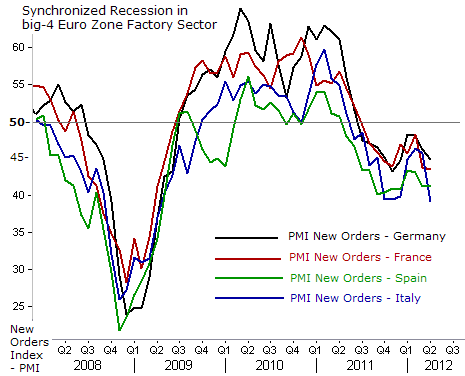4 Tips For Buying Stocks In A Recession
Post on: 31 Март, 2015 No Comment

Equities tend to outperform other asset classes and should not be entirely ignored — even during periods of recession. If this sounds scary, don’t worry: it is possible to choose the right investment candidates and to mitigate risk during tough economic times.
In fact, in a January 2008 Washington Post story entitled Five Myths About That Depressing R-Word, Kevin Hassett writes: With the economy heading south during recessions, the conventional wisdom is that stock prices drop as well. However, the market tends to look ahead and starts to respond favorably to the expected end of a recession long before it occurs. Influential economist Donald Luskin of Trend Macrolytics recently ran the numbers and found that stocks have produced an average return of 12.1% in post-World War II recessions. This is only slightly below the average return outside recessions
Keep reading for some tips on how to invest in a troubled economy.
- Think Resilience
During recessionary periods, individuals aren’t able to spend as much money on high-tech gadgets or big-ticket items, such as cars or high-end electronics; instead, people tend to put their dollars toward necessities, such as food or utilities. In addition, according to a McGraw-Hill study of advertising performance, companies that can afford to advertise will win consumers at the local markets, regardless of bran- name recognition pre-recession, making them strong contenders for your portfolio.
According to the same McGraw-Hill study, business-to-business firms that maintained or increased their advertising expenditures during the 1981-82 recession averaged significantly higher sales growth both during the recession and for the following three years than those that eliminated or decreased advertising (When The Going Gets Tough, The Tough Ramp Up, San Diego Daily Transcript. May 2001).
In addition. MarketSense compared 101 household name brands during the recessionary period of 1989-1991. Jell-O, Crisco, Hellman’s, Green Giant and Doritos saw sales drop by as much as 26-64%. Jiff peanut butter raised ad support and sales went up 57%; Kraft salad dressings saw a rise of 70%. In the beer category, overall spending was down 1%, while Bud Light and Coors Light, each spending ahead of the category, saw sales increases of 15% and 16%, respectively. Pizza Hut sales rose 61% and Taco Bell’s 40% thanks to strong advertising support, with McDonald’s volume down approximately 28%.
In recessionary periods or bear markets doing your homework is extremely important because overpaying for a stock can have catastrophic consequences.
There are no hard-and-fast rules and certainly no guarantees to help you avoid overpaying. However, you can try to purchase shares in (promising) companies that trade below their tangible book values. Why? In an economic slowdown, earnings might decelerate or even be non-existent. When that happens, something tangible can protect the downside.
In a perfect world, when you purchase shares in a company that trades below tangible book value, even if the company breaks up and is sold off in pieces, you, as the shareholder, may still have a chance of being made whole again through asset sales. (To learn more, read Digging Into Book Value .)
If a company has been consistently reporting bad news and its stock has been in decline, a risky proposition would be to buy the shares in a recession. After all, who knows whether the worst is over and the stock has bottomed out? In short, the best advice might be to avoid a stock until the stream of bad news appears to have ended, or the market has turned enough to let you have a risk cushion.
But how can you tell if the worst is over? It’s not always easy, but you should generally look for the following hints:
Although this may go without saying, diversify your holdings when possible. This doesn’t mean simply spreading holdings across a handful of stocks, but diversifying by industry and, if suitable, getting some overseas exposure too.
Let’s take a look at some common diversification questions:
1) Why is diversification so important during a bear market ? Very simply, picking a bottom in a given stock, industry, or market is difficult or impossible. Therefore, limiting exposure to a particular security or group of securities makes more sense. You are more likely to stay afloat if you grab many life preservers, rather than just one (which may not keep your head above water in bad weather).
2) How much should an investor diversify? Some investors believe that diversification can be obtained with approximately 10 to 20 stock holdings, while others believe in an even larger number of holdings and a variety of asset types. (Keep reading about diversification techniques in Introduction To Diversification . Risk And Diversification and The Dangers Of Over-Diversification .)
3) What other ways can I diversify? For one, consider mutual funds as a way of obtaining diversification. However, you can choose to explore certain asset allocation strategies and asset classes that best suit your risk tolerance instead. Whatever way you diversity, and before you invest, it would be wise to consult an advisor. Discuss your unique situation with the advisor to make sure your investments are consistent with your risk tolerance and financial means. (To read more, see Diversification: It’s All About (Asset) Class. Diversification Beyond Equities and Has Your Fund Manager Been Through A Bear Market? ) A properly diversified portfolio can help smooth returns and make the road to financial security less bumpy.
Bottom Line
Risks are associated with buying equities in bear markets. However, with a little homework, you can mitigate some of that risk. Over time, stocks have proved to be a very resilient asset class, and they needn’t be avoided if you know how to handle them.














